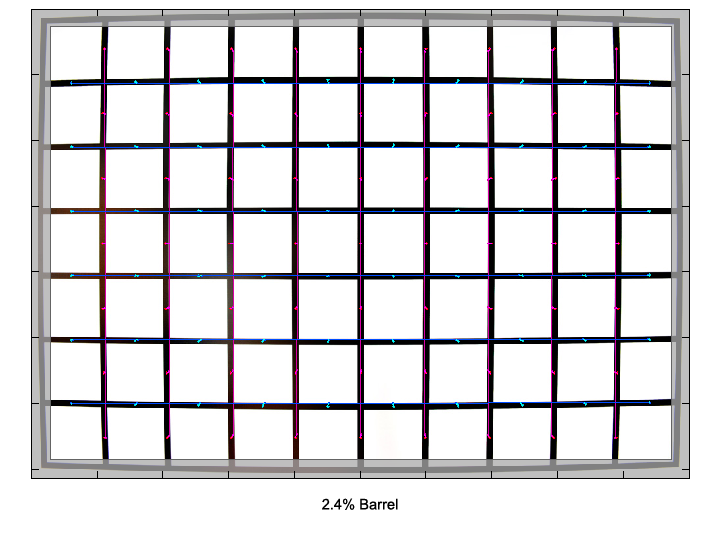|
Page 2 of 3

Distortion
The lens shows a distortion behaviour that is typical for many standard zooms. At the wide end, there is visible barrel distortion, however with an amount of 2.4% the issue is comparatively well controlled. At medium focal length settings, there is no visible distortion, while at the long end of the zoom range the lens shows a small amount of pincushion distortion.
|
Move the mouse cursor over the focal length text marks below to observe the respective distortion
|
| 28mm |
40mm |
70mm |
|

|
The chart above has a real-world size of about 120x80cm.
Vignetting
Vignetting is well under control for such a fast zoom lens. As expected, it is most pronounced wide open, but as usual stopping down reduces the amount of light fall-off. From f/4 onwards it should not be an issue for most subjects.
We're performing our vignetting analysis based on
(uncorrected) JPEGs straight from the camera. The JPG engine of the Nikon D3x features a rather flat
gradation curve, thus has a moderate contrast characteristic, resulting in comparatively low vignetting figures - the
corresponding Canon figures are roughly 40% higher due to the more
aggressive default contrast setting.

MTF (resolution)
At 28mm the lens delivers very good resolution in the image center and excellent values when stopped down. The border show very good resolution at all tested apertures. The extreme corners start a bit lower with good resolution wide open, but increase to very good values stopped down.
Zoomed in to 40mm, the situation is very similar, but both borders and corners managed to reach excellent resolution when stopped down to f/8.
At the longest focal length setting, the center resolution drops a bit in general, but still manages to reach excellent values from f/4 onwards. Both borders and corners show very good resolution at all tested apertures.
The Nikkor showed a slight amount of focus shift when stopping down (residual spherical aberration).
Please note that the MTF results are not directly comparable across the different systems!
Below is a simplified summary of the formal findings. The chart shows line widths
per picture height (LW/PH) which can be taken as a measure for sharpness.
If you want to know more about the MTF50 figures you may check out the corresponding
Imatest Explanations

Chromatic Aberrations (CAs)
Chromatic aberrations (color shadows at harsh contrast transitions) are well controlled at most focal lengths. Only at 70mm wide open they are a little pronounced, but stopping down slightly already reduces the amount.
Please note that lateral CAs can easily be corrected in software or by the camera itself (most modern Nikon DSLRs remove CAs on-the-fly if you shoot JPGs).

Bokeh
Being a fast lens, the Nikkor allows for good subject separation and thus the quality of out-of-focus blur is certainly of interest. We looked at bokeh with our standard test scene at 70mm focal length, which is closest to classic head to shoulder portrait lenses (~85mm).
The general quality of image blur in front of the focal plane is very smooth. Unfortunately this is not something you'll be able to benefit from in the field too often.
The more important background blur is of lower quality. The lens renders a quite nervous bokeh.
Thanks to 9 rounded aperture blades, background highlights retain their circular shape throughout the whole aperture range. However, the highlights show a significant amount of outlining, which adds nervousness to already busy backgrounds.

Bokeh Fringing
Bokeh fringing (non-coinciding focal planes of the various colors) is an issue often found on fast lenses. It's visible as halos of different colors in out-of-focus areas - usually magenta (red + blue) in front the focus point and green beyond.
The Nikkor shows some bokeh fringing wide open, but stopping down reduces the issue to a negligible level.
In addition, these shots also show the focus shift when stopping down, which was mentioned in the MTF section.
|